CADILLAC STS 2009 1.G Owners Manual
Manufacturer: CADILLAC, Model Year: 2009, Model line: STS, Model: CADILLAC STS 2009 1.GPages: 514, PDF Size: 2.73 MB
Page 101 of 514

Stopping the Engine
Move the shift lever to P (Park) and press the
Acc. button located on the instrument panel. If the
shifter is not in P (Park), the engine shuts off and the
vehicle goes into the Accessory Mode. The DIC
displays SHIFT TO PARK. Once the shifter is moved
to P (Park), the vehicle turns off.
The DIC displays NO FOB, OFF OR RUN?, if the
keyless access transmitter is not detected inside the
vehicle when it is turned off.
SeeDIC Warnings and Messages on page 3-79for
more information.
Engine Coolant Heater
The engine coolant heater can provide easier starting
and better fuel economy during engine warm-up in cold
weather conditions at or below 0°F (−18°C). Vehicles with
an engine coolant heater should be plugged in at least
four hours before starting. Some models have an internal
thermostat in the cord which will prevent engine coolant
heater operation at temperatures above 0°F (−18°C).
To Use the Engine Coolant Heater
1. Turn off the engine.
2. Open the hood and unwrap the electrical cord.
For the 3.6L V6 and 4.4L V8 engine, the cord is
located in the front of the engine compartment,
on the passenger side of the vehicle.
For the 4.6L V8 engine, the cord is located in the
engine compartment on the driver side of the vehicle
near the inner fender and above the strut.
3. You must remove the plastic cap to access
the plug.
4. Plug it into a normal, grounded 110-volt AC outlet.
{CAUTION:
Plugging the cord into an ungrounded outlet could
cause an electrical shock. Also, the wrong kind of
extension cord could overheat and cause a �re.
You could be seriously injured. Plug the cord into a
properly grounded three-prong 110-volt AC outlet.
If the cord will not reach, use a heavy-duty
three-prong extension cord rated for at least
15 amps.
2-29
Page 102 of 514
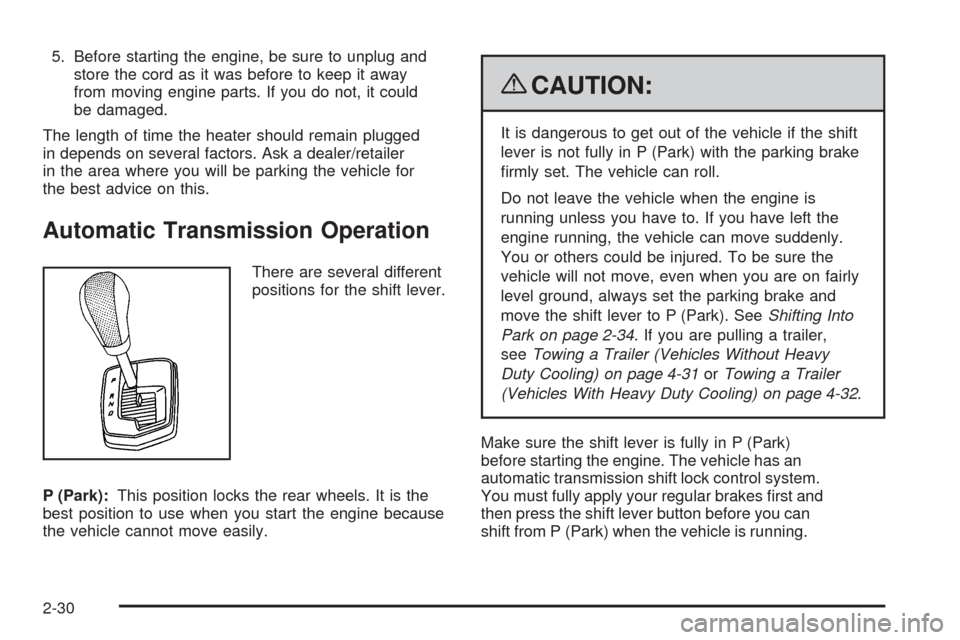
5. Before starting the engine, be sure to unplug and
store the cord as it was before to keep it away
from moving engine parts. If you do not, it could
be damaged.
The length of time the heater should remain plugged
in depends on several factors. Ask a dealer/retailer
in the area where you will be parking the vehicle for
the best advice on this.
Automatic Transmission Operation
There are several different
positions for the shift lever.
P (Park):This position locks the rear wheels. It is the
best position to use when you start the engine because
the vehicle cannot move easily.
{CAUTION:
It is dangerous to get out of the vehicle if the shift
lever is not fully in P (Park) with the parking brake
�rmly set. The vehicle can roll.
Do not leave the vehicle when the engine is
running unless you have to. If you have left the
engine running, the vehicle can move suddenly.
You or others could be injured. To be sure the
vehicle will not move, even when you are on fairly
level ground, always set the parking brake and
move the shift lever to P (Park). SeeShifting Into
Park on page 2-34. If you are pulling a trailer,
seeTowing a Trailer (Vehicles Without Heavy
Duty Cooling) on page 4-31orTowing a Trailer
(Vehicles With Heavy Duty Cooling) on page 4-32.
Make sure the shift lever is fully in P (Park)
before starting the engine. The vehicle has an
automatic transmission shift lock control system.
You must fully apply your regular brakes �rst and
then press the shift lever button before you can
shift from P (Park) when the vehicle is running.
2-30
Page 103 of 514

If you cannot shift out of P (Park), ease pressure on
the shift lever and push the shift lever all the way into
P (Park) as you maintain brake application. Then press
the shift lever button and move the shift lever into another
gear. SeeShifting Out of Park on page 2-35.
Notice:Shifting to R (Reverse) while the vehicle is
moving forward could damage the transmission.
The repairs would not be covered by the vehicle
warranty. Shift to R (Reverse) only after the vehicle
is stopped.
R (Reverse):Use this gear to back up.
At low vehicle speeds, you can also use R (Reverse)
to rock your vehicle back and forth to get out of
snow, ice, or sand without damaging the transmission.
SeeIf Your Vehicle is Stuck in Sand, Mud, Ice, or
Snow on page 4-23for additional information.
N (Neutral):In this position, the engine does not
connect with the wheels. To restart the engine when
the vehicle is already moving, use N (Neutral) only.
You can also use N (Neutral) when the vehicle is
being towed.
{CAUTION:
Shifting into a drive gear while the engine is
running at high speed is dangerous. Unless your
foot is �rmly on the brake pedal, the vehicle could
move very rapidly. You could lose control and hit
people or objects. Do not shift into a drive gear
while the engine is running at high speed.
Notice:Shifting out of P (Park) or N (Neutral) with
the engine running at high speed may damage the
transmission. The repairs would not be covered
by the vehicle warranty. Be sure the engine is not
running at high speed when shifting the vehicle.
D (Drive):This position is for normal driving. It provides
the best fuel economy. If you need more power for
passing, and you are:
Going less than 35 mph (55 km/h), push the
accelerator pedal about halfway down.
Going about 35 mph (55 km/h) or more, push the
accelerator all the way down.
The transmission will shift down to a lower gear
and have more power.
Downshifting the transmission in slippery road conditions
could result in skidding, see “Skidding” underLoss of
Control on page 4-15.
2-31
Page 104 of 514
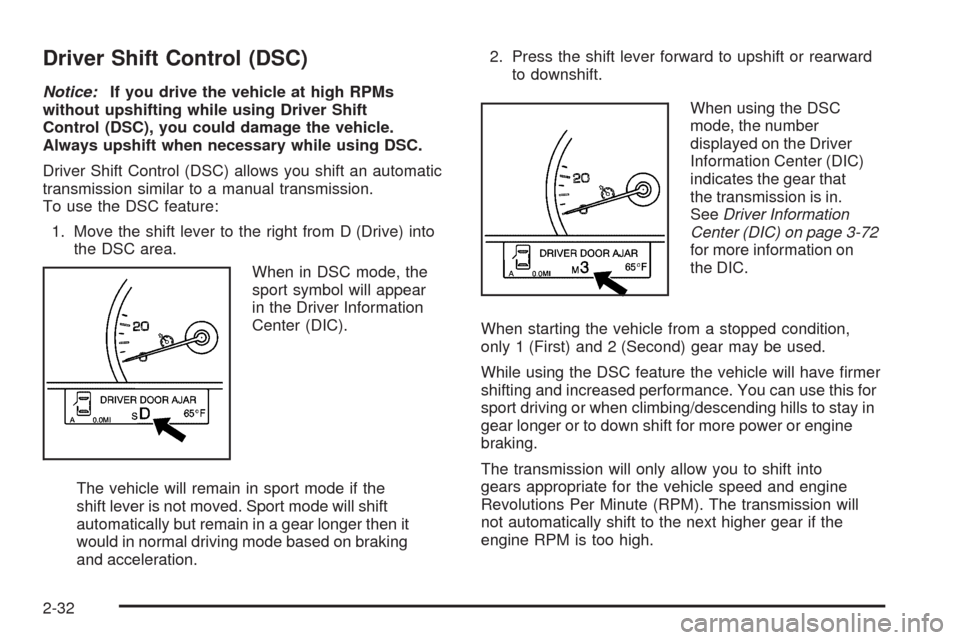
Driver Shift Control (DSC)
Notice:If you drive the vehicle at high RPMs
without upshifting while using Driver Shift
Control (DSC), you could damage the vehicle.
Always upshift when necessary while using DSC.
Driver Shift Control (DSC) allows you shift an automatic
transmission similar to a manual transmission.
To use the DSC feature:
1. Move the shift lever to the right from D (Drive) into
the DSC area.
When in DSC mode, the
sport symbol will appear
in the Driver Information
Center (DIC).
The vehicle will remain in sport mode if the
shift lever is not moved. Sport mode will shift
automatically but remain in a gear longer then it
would in normal driving mode based on braking
and acceleration.2. Press the shift lever forward to upshift or rearward
to downshift.
When using the DSC
mode, the number
displayed on the Driver
Information Center (DIC)
indicates the gear that
the transmission is in.
SeeDriver Information
Center (DIC) on page 3-72
for more information on
the DIC.
When starting the vehicle from a stopped condition,
only 1 (First) and 2 (Second) gear may be used.
While using the DSC feature the vehicle will have �rmer
shifting and increased performance. You can use this for
sport driving or when climbing/descending hills to stay in
gear longer or to down shift for more power or engine
braking.
The transmission will only allow you to shift into
gears appropriate for the vehicle speed and engine
Revolutions Per Minute (RPM). The transmission will
not automatically shift to the next higher gear if the
engine RPM is too high.
2-32
Page 105 of 514

If shifting is prevented for any reason, the selected gear
will �ash multiple times, indicating that the transmission
has not shifted gears.
The transmission will allow you to shift to the gear
selected and will automatically downshift when the
vehicle comes to a stop. This will allow for more
power during take-off and passing.
Parking Brake
The parking brake pedal is
located on the lower portion
of the instrument panel to
the left of the steering
wheel.
The vehicle has a push-to-release parking brake pedal.
To set the parking brake, hold the brake pedal down,
then push the parking brake pedal down.If the ignition is on, the brake system warning light on
the instrument panel cluster should come on. If it does
not, you need to have the vehicle serviced. SeeBrake
System Warning Light on page 3-62for more information.
To release the parking brake, hold the brake pedal
down, then push the parking brake pedal. When you
release the park brake pedal, the parking brake
releases.
Notice:Driving with the parking brake on can
overheat the brake system and cause premature
wear or damage to brake system parts. Make sure
that the parking brake is fully released and the brake
warning light is off before driving.
A warning chime will sound if the parking brake is set,
the ignition is on and the vehicle begins to move.
To stop the chime, fully release the parking brake.
If you are towing a trailer and parking on a hill,
seeTowing a Trailer (Vehicles Without Heavy Duty
Cooling) on page 4-31orTowing a Trailer (Vehicles
With Heavy Duty Cooling) on page 4-32for more
information.
2-33
Page 106 of 514
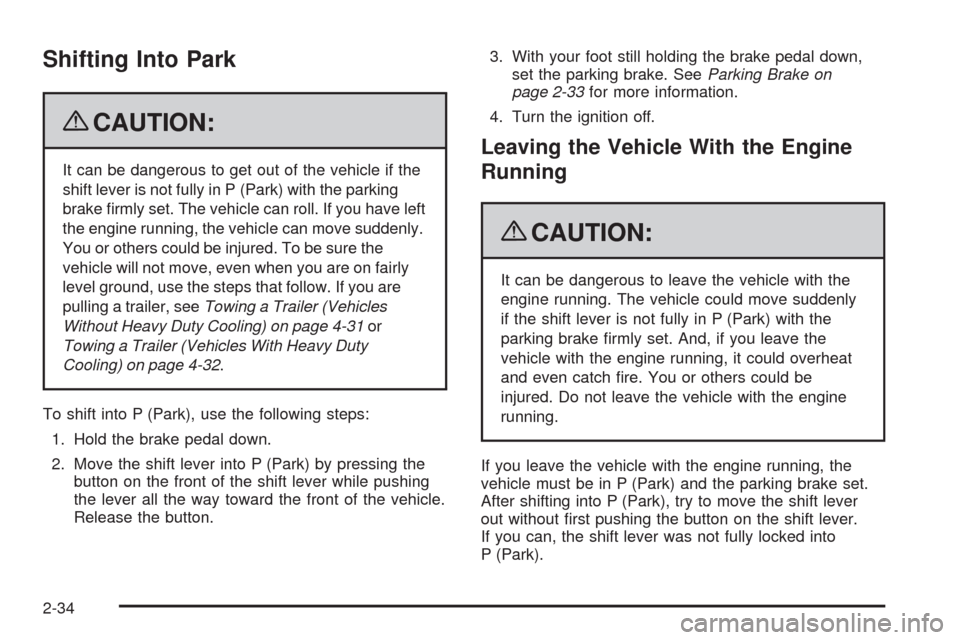
Shifting Into Park
{CAUTION:
It can be dangerous to get out of the vehicle if the
shift lever is not fully in P (Park) with the parking
brake �rmly set. The vehicle can roll. If you have left
the engine running, the vehicle can move suddenly.
You or others could be injured. To be sure the
vehicle will not move, even when you are on fairly
level ground, use the steps that follow. If you are
pulling a trailer, seeTowing a Trailer (Vehicles
Without Heavy Duty Cooling) on page 4-31or
Towing a Trailer (Vehicles With Heavy Duty
Cooling) on page 4-32.
To shift into P (Park), use the following steps:
1. Hold the brake pedal down.
2. Move the shift lever into P (Park) by pressing the
button on the front of the shift lever while pushing
the lever all the way toward the front of the vehicle.
Release the button.3. With your foot still holding the brake pedal down,
set the parking brake. SeeParking Brake on
page 2-33for more information.
4. Turn the ignition off.
Leaving the Vehicle With the Engine
Running
{CAUTION:
It can be dangerous to leave the vehicle with the
engine running. The vehicle could move suddenly
if the shift lever is not fully in P (Park) with the
parking brake �rmly set. And, if you leave the
vehicle with the engine running, it could overheat
and even catch �re. You or others could be
injured. Do not leave the vehicle with the engine
running.
If you leave the vehicle with the engine running, the
vehicle must be in P (Park) and the parking brake set.
After shifting into P (Park), try to move the shift lever
out without �rst pushing the button on the shift lever.
If you can, the shift lever was not fully locked into
P (Park).
2-34
Page 107 of 514
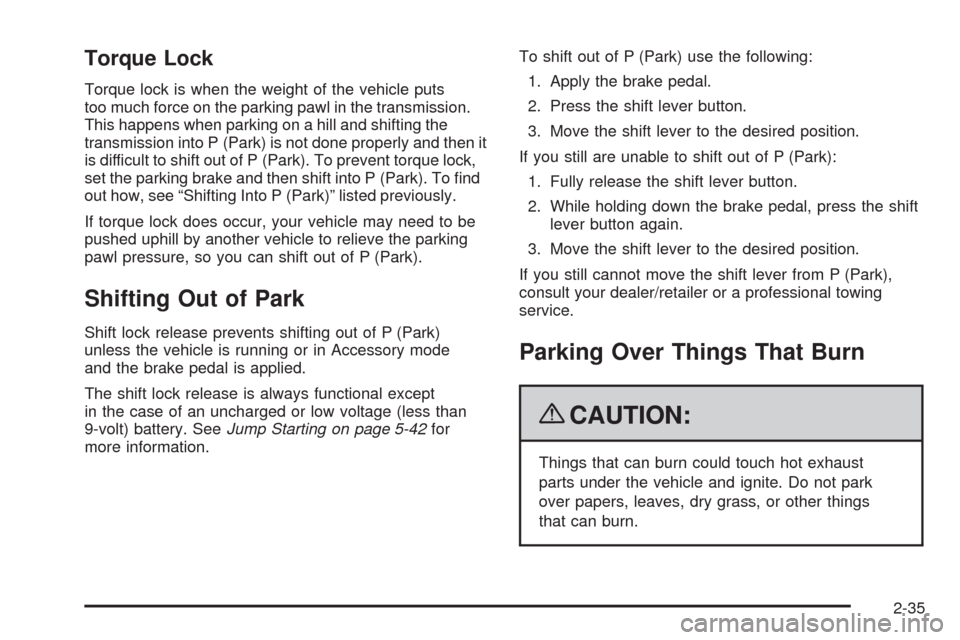
Torque Lock
Torque lock is when the weight of the vehicle puts
too much force on the parking pawl in the transmission.
This happens when parking on a hill and shifting the
transmission into P (Park) is not done properly and then it
is difficult to shift out of P (Park). To prevent torque lock,
set the parking brake and then shift into P (Park). To �nd
out how, see “Shifting Into P (Park)” listed previously.
If torque lock does occur, your vehicle may need to be
pushed uphill by another vehicle to relieve the parking
pawl pressure, so you can shift out of P (Park).
Shifting Out of Park
Shift lock release prevents shifting out of P (Park)
unless the vehicle is running or in Accessory mode
and the brake pedal is applied.
The shift lock release is always functional except
in the case of an uncharged or low voltage (less than
9-volt) battery. SeeJump Starting on page 5-42for
more information.To shift out of P (Park) use the following:
1. Apply the brake pedal.
2. Press the shift lever button.
3. Move the shift lever to the desired position.
If you still are unable to shift out of P (Park):
1. Fully release the shift lever button.
2. While holding down the brake pedal, press the shift
lever button again.
3. Move the shift lever to the desired position.
If you still cannot move the shift lever from P (Park),
consult your dealer/retailer or a professional towing
service.
Parking Over Things That Burn
{CAUTION:
Things that can burn could touch hot exhaust
parts under the vehicle and ignite. Do not park
over papers, leaves, dry grass, or other things
that can burn.
2-35
Page 108 of 514
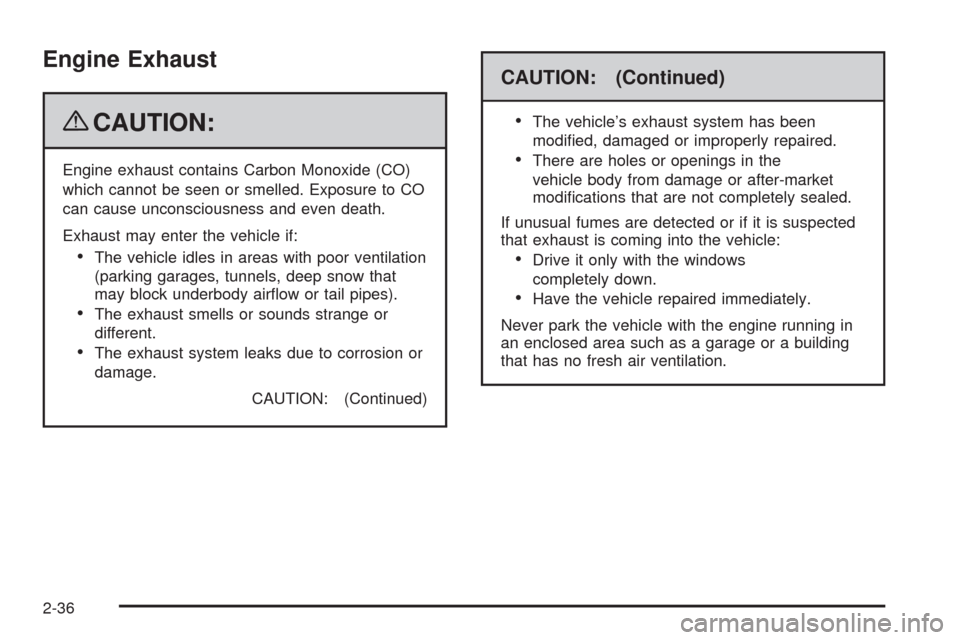
Engine Exhaust
{CAUTION:
Engine exhaust contains Carbon Monoxide (CO)
which cannot be seen or smelled. Exposure to CO
can cause unconsciousness and even death.
Exhaust may enter the vehicle if:
The vehicle idles in areas with poor ventilation
(parking garages, tunnels, deep snow that
may block underbody air�ow or tail pipes).
The exhaust smells or sounds strange or
different.
The exhaust system leaks due to corrosion or
damage.
CAUTION: (Continued)
CAUTION: (Continued)
The vehicle’s exhaust system has been
modi�ed, damaged or improperly repaired.
There are holes or openings in the
vehicle body from damage or after-market
modi�cations that are not completely sealed.
If unusual fumes are detected or if it is suspected
that exhaust is coming into the vehicle:
Drive it only with the windows
completely down.
Have the vehicle repaired immediately.
Never park the vehicle with the engine running in
an enclosed area such as a garage or a building
that has no fresh air ventilation.
2-36
Page 109 of 514
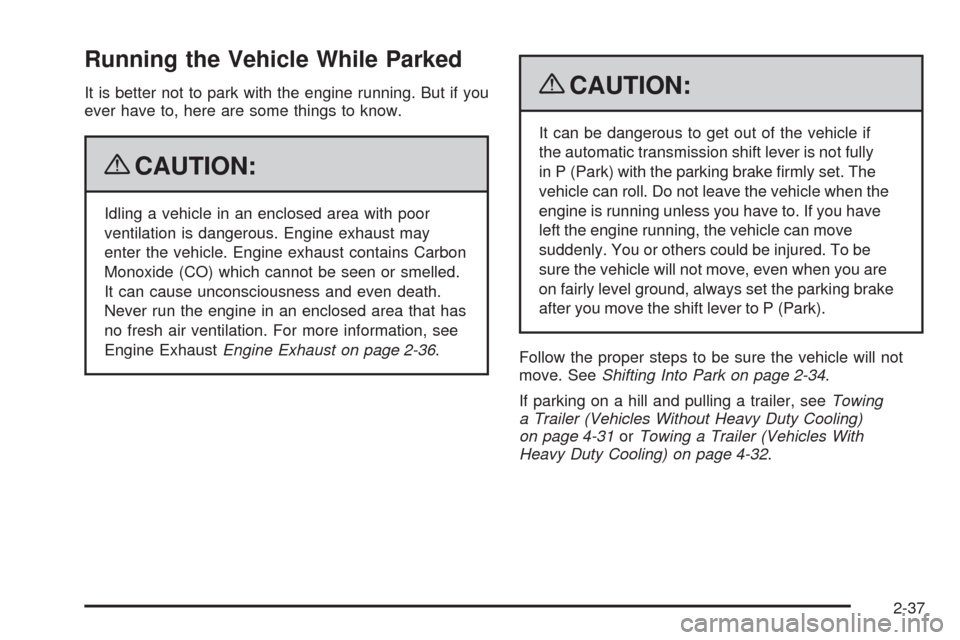
Running the Vehicle While Parked
It is better not to park with the engine running. But if you
ever have to, here are some things to know.
{CAUTION:
Idling a vehicle in an enclosed area with poor
ventilation is dangerous. Engine exhaust may
enter the vehicle. Engine exhaust contains Carbon
Monoxide (CO) which cannot be seen or smelled.
It can cause unconsciousness and even death.
Never run the engine in an enclosed area that has
no fresh air ventilation. For more information, see
Engine ExhaustEngine Exhaust on page 2-36.
{CAUTION:
It can be dangerous to get out of the vehicle if
the automatic transmission shift lever is not fully
in P (Park) with the parking brake �rmly set. The
vehicle can roll. Do not leave the vehicle when the
engine is running unless you have to. If you have
left the engine running, the vehicle can move
suddenly. You or others could be injured. To be
sure the vehicle will not move, even when you are
on fairly level ground, always set the parking brake
after you move the shift lever to P (Park).
Follow the proper steps to be sure the vehicle will not
move. SeeShifting Into Park on page 2-34.
If parking on a hill and pulling a trailer, seeTowing
a Trailer (Vehicles Without Heavy Duty Cooling)
on page 4-31orTowing a Trailer (Vehicles With
Heavy Duty Cooling) on page 4-32.
2-37
Page 110 of 514

Mirrors
Automatic Dimming Rearview Mirror
The vehicle may have an automatic dimming inside
rearview mirror with OnStar®controls; or it may have
OnStar and a compass display. SeeOnStar®System
on page 2-50and/orCompass on page 2-38for
more information.
The vehicle could have an Intellibeam™ inside rearview
mirror with OnStar controls. See “Intellibeam Intelligent
High-Beam Headlamp Control System” underHeadlamps
on page 3-32for more information.
For vehicles with OnStar
®:
O(On/Off):Press to turn the dimming feature on
or off.
For vehicles without OnStar
®:
AUTO/
((On/Off):Press and hold to turn the dimming
feature on or off.
Automatic Dimming Mirror Operation
Automatic dimming reduces the glare of lights from
behind the vehicle. The dimming feature comes on and
the indicator light illuminates each time the vehicle is
started.
To turn on and start Intellibeam™, press the
Intellibeam™ button on the inside rearview mirror.
If the vehicle has the IntelliBeam™ Intelligent High-Beam
Headlamp Control System,
Ocan also be used to turn
off or reset this system. See “IntelliBeam™ Intelligent
High-Beam Headlamp Control System” underHeadlamps
on page 3-32.
Cleaning the Mirror
Do not spray glass cleaner directly on the mirror.
Use a soft towel dampened with water.
Compass
Compass Operation
PressOto turn the compass on or off.
When the ignition and the compass feature are on,
the mirror displays the compass heading after a
few seconds.
2-38